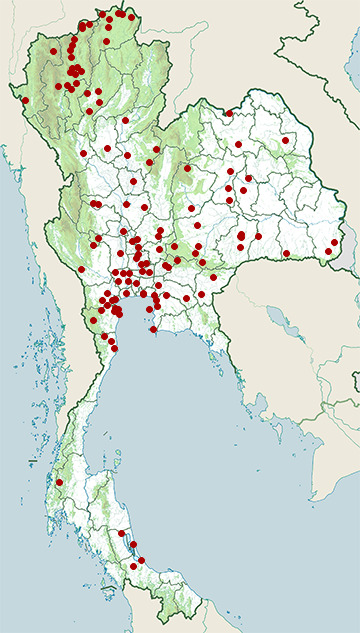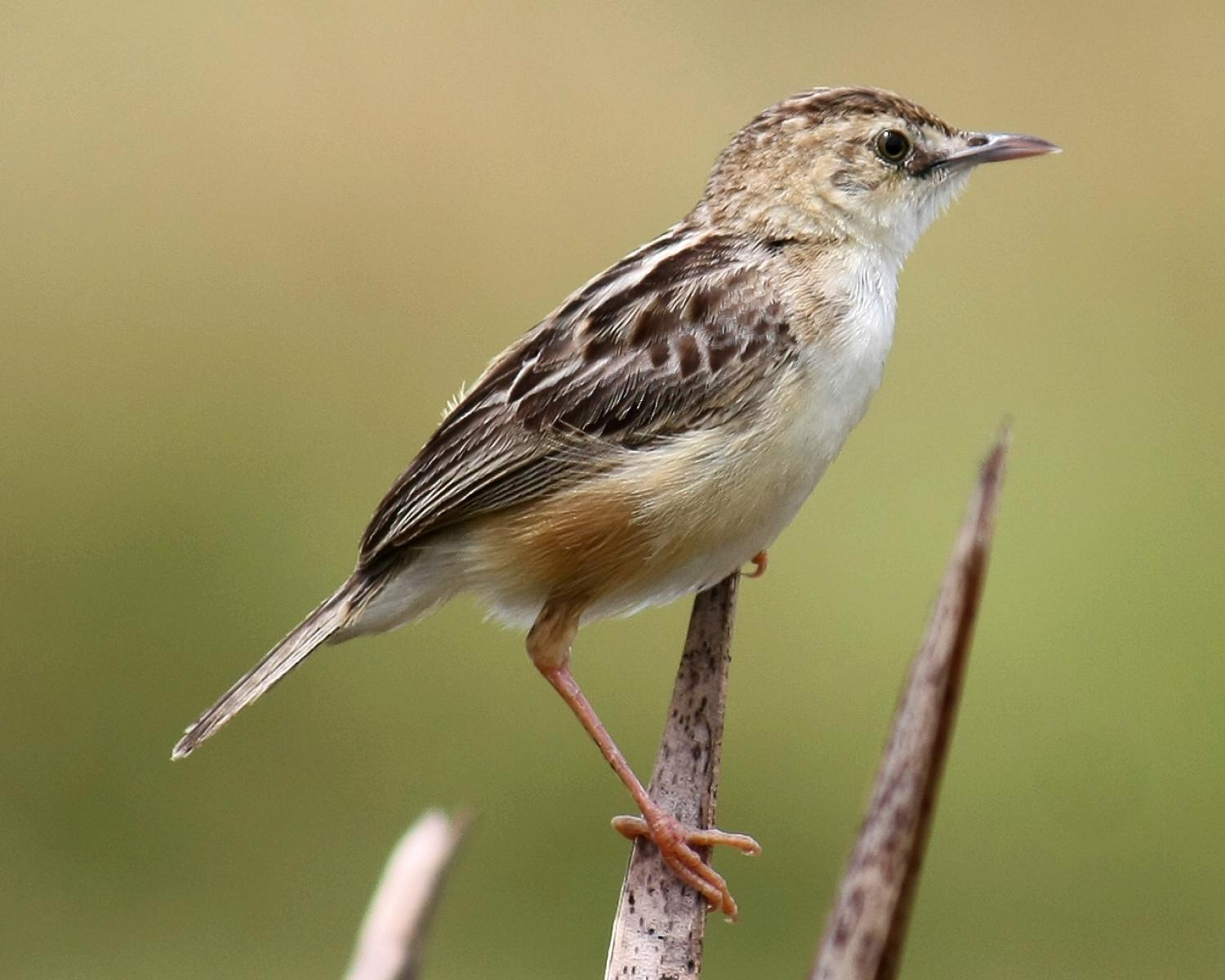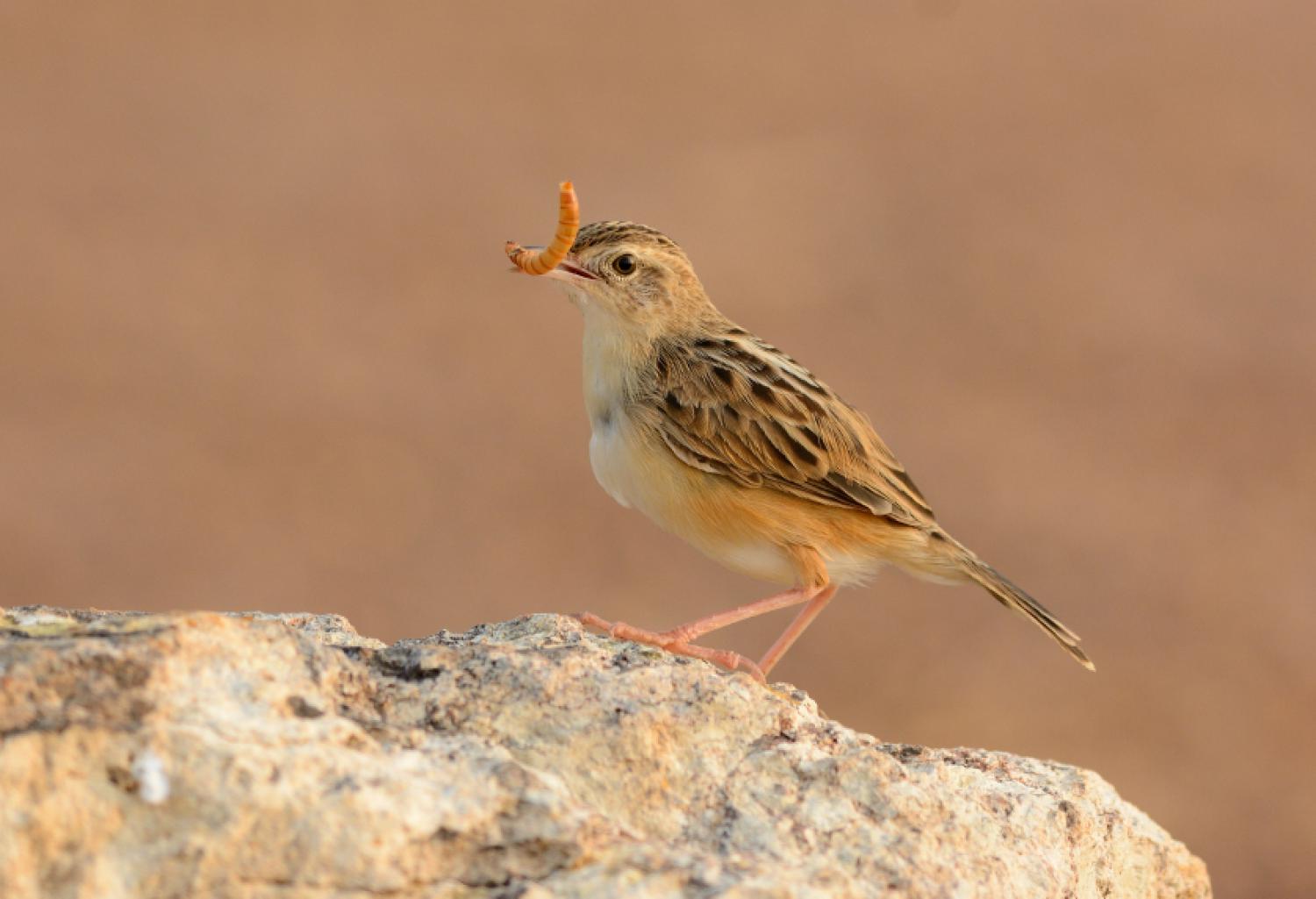Species of Thailand
Zitting cisticola
Cisticola juncidis
Constantine Samuel Rafinesque, 1810
In Thai: นกยอดข้าวหางแพนลาย
The zitting cisticola or streaked fantail warbler (Cisticola juncidis), is a widely distributed Old World warbler whose breeding range includes southern Europe, Africa (outside the deserts and rainforest), and southern Asia down to northern Australia. A small bird found mainly in grasslands, it is best identified by its rufous rump; as well, it lacks any gold on the collar and the brownish tail is tipped with white. During the breeding season, males have a zigzagging flight display accompanied by regular "zitting" calls that have been likened to repeated snips of a scissor. They build their pouch nest suspended within a clump of grass.
Taxonomy and systematics
The zitting cisticola was described by the naturalist Constantine Samuel Rafinesque in 1810 and given the binomial name Sylvia juncidis. The type locality is Campofelice di Roccella in Sicily. The current genus name Cisticola is from Ancient Greek kisthos, "rock-rose", and Latin colere, "to dwell". The specific juncidis is also from Latin and is a diminutive of iuncus, reed".
Across their wide distribution range, several variations in populations have been noted and as many as 18 subspecies are recognized. They differ slightly in calls, plumage and size and some have been considered full species in some taxonomic treatments. The nominate form is found in southern France, Greece, Turkey, Sicily, Corsica and Egypt while western Portugal and Spain have cisticola. The population in Palestine, Syria, Iraq and Iran is neuroticus while the northern and eastern African population is uropygialis and perennius (further south). Gabon, Angola, and southern Africa are home to terrestris. The population in the Western Ghats of India, salimalii, does not show seasonal tail length variation as in cursitans of the plains of India and dry-zone of Sri Lanka, which has a longer tail in the non-breeding season. Population malaya is found in southern Southeast Asia, tinnabulans further north in southern China while brunniceps is found in Korea and Japan. Other populations include nigrostriatus (Philippines), constans (Sulawesi), fuscicapilla (east Java), leanyeri (northern Australia), normani (northwest Queensland) and laveryi (northeast Australia).
This genus is sometimes split off with various other southern warbler genera and given family status as the Cisticolidae. This species was previously known as Fan-tailed Warbler, but the current name gives consistency with the many tropical cisticola species, and avoids confusion with an American species also named fan-tailed warbler.
Description
The zitting cisticola is 10 to 12 cm in length. It is brown above, heavily streaked with black markings. The underparts are whitish, and the tail is broad, white-tipped and flicked frequently, giving rise to the alternative name for the species. The adult males have less crown streaking and more back marking than the females, but there are no great difference between the sexes or the eighteen geographical races. The absence of a nuchal collar separate it from the golden-headed cisticola (Cisticola exilis). In the non-breeding season, they tend to skulk within the grass and can be hard to spot.
Habitat and distribution
This species is found mainly in grassland habitats, often near water. Most populations are resident, but some East Asian populations migrate south to warmer areas in winter. In the Himalayas, they ascend to about 1900 m during summer but are below 1300 m in the winter. This species is a rare vagrant to northern Europe, mostly as a spring overshoot. Its European range is generally expanding, although northern populations are especially susceptible to hard winters.
Behaviour and ecology
Zitting cisticolas are very small insectivorous birds, sometimes found in small groups. The breeding season is associated with the rains. Two broods a year occur in many regions. Males are polygynous but some are monogamous the male builds the initial nest structure deep in the grasses, and invites females using a special display. Females that accept the male complete the nest. The nest is made by binding living leaves into the soft fabric of felted plant-down, cobwebs, and grass. The zitting cisticola's nest is a cup shape with a canopy of tied-together leaves or grasses overhead for camouflage; 3–6 eggs are laid. The female incubates the egg. The eggs hatch after about 10 days. More than one brood may be raised. Females change their mates frequently and rarely stay within the same territory, while males are less mobile, maintaining non-overlapping song-territories which shifted from day to day. Females can sometimes breed in their first year.
This article uses material from Wikipedia released under the Creative Commons Attribution-Share-Alike Licence 3.0. Eventual photos shown in this page may or may not be from Wikipedia, please see the license details for photos in photo by-lines.
Category / Seasonal Status
BCST Category: Recorded in an apparently wild state within the last 50 years
BCST Seasonal status: Resident or presumed resident
Scientific classification
- Kingdom
- Animalia
- Phylum
- Chordata
- Class
- Aves
- Order
- Passeriformes
- Family
- Cisticolidae
- Genus
- Cisticola
- Species
- Cisticola juncidis
Common names
- English:
- Zitting cisticola
- Fan-tailed cisticola
- Fan-tailed warbler
- French: Cisticole des joncs
- Thai: นกยอดข้าวหางแพนลาย
Synonyms
- Cisticola juncidus juncidus, Les Christidis & Walter E. Boles (2008)
Conservation status

Least Concern (IUCN3.1)
Photos
Please help us review the bird photos if wrong ones are used. We can be reached via our contact us page.
Range Map

- Amphawa District, Samut Songkhram
- Ban Laem District, Phetchaburi
- Ban Phai District, Khon Kaen
- Ban Phraek District, Phra Nakhon Si Ayutthaya
- Bang Ban District, Phra Nakhon Si Ayutthaya
- Bang Len District, Nakhon Pathom
- Bang Pa In District, Phra Nakhon Si Ayutthaya
- Bang Pahan District, Phra Nakhon Si Ayutthaya
- Bang Pakong District, Chachoengsao
- Bang Phra Non-Hunting Area
- Bang Pu Recreation Centre
- Bangkok Province
- Borabue District, Maha Sarakham
- Bueng Boraped Non-Hunting Area
- Buntharik District, Ubon Ratchathani
- Chatturat District, Chaiyaphum
- Chiang Dao District, Chiang Mai
- Chiang Dao Wildlife Sanctuary
- Chiang Khong District, Chiang Rai
- Chiang Saen District, Chiang Rai
- Chum Ta Bong District, Nakhon Sawan
- Dan Chang District, Suphan Buri
- Doi Inthanon National Park
- Doi Lo District, Chiang Mai
- Doi Pha Hom Pok National Park
- Doi Saket District, Chiang Mai
- Doi Suthep - Pui National Park
- Fang District, Chiang Mai
- Hang Chat District, Lampang
- Hat Yai District, Songkhla
- Hua Hin District, Prachuap Khiri Khan
- Huai Chorakhe Mak Reservoir Non-Hunting Area
- Huai Sala Wildlife Sanctuary
- Huai Talat Reservoir Non-Hunting Area
- Kaeng Khoi District, Saraburi
- Kaeng Krachan National Park
- Kamphaeng Saen District, Nakhon Pathom
- Kantharawichai District, Maha Sarakham
- Khao Sam Roi Yot National Park
- Khao Sok National Park
- Khao Yai National Park
- Khao Yoi District, Phetchaburi
- Khlong Luang District, Pathum Thani
- Khon San District, Chaiyaphum
- Ko Sichang District, Chonburi
- Kumphawapi District, Udon Thani
- Laem Pak Bia
- Mae Ai District, Chiang Mai
- Mae Chan District, Chiang Rai
- Mae Fa Luang District, Chiang Rai
- Mae Poen District, Nakhon Sawan
- Mae Rim District, Chiang Mai
- Mae Taeng District, Chiang Mai
- Mae Tha, Lampang District, Lampang
- Mueang Buriram District, Buriram
- Mueang Chachoengsao District, Chachoengsao
- Mueang Chiang Mai District, Chiang Mai
- Mueang Chiang Rai District, Chiang Rai
- Mueang Chonburi District, Chonburi
- Mueang Khon Kaen District, Khon Kaen
- Mueang Lampang District, Lampang
- Mueang Lamphun District, Lamphun
- Mueang Nakhon Nayok District, Nakhon Nayok
- Mueang Nakhon Pathom District, Nakhon Pathom
- Mueang Nong Khai District, Nong Khai
- Mueang Phetchaburi District, Phetchaburi
- Mueang Phitsanulok District, Phitsanulok
- Mueang Ratchaburi District, Ratchaburi
- Mueang Samut Sakhon District, Samut Sakhon
- Mueang Samut Songkhram District, Samut Songkhram
- Mueang Songkhla District, Songkhla
- Mueang Sukhothai District, Sukhothai
- Mueang Suphanburi District, Suphan Buri
- Mueang Surin District, Surin
- Mueang Tak District, Tak
- Mueang Uttaradit District, Uttaradit
- Na Chaluai District, Ubon Ratchathani
- Non Thai District, Nakhon Ratchasima
- Nong Bong Khai Non-Hunting Area
- Nong Han Lake
- Nong Prue District, Kanchanaburi
- Nong Song Hong District, Khon Kaen
- Nong Ya Plong District, Phetchaburi
- Pa Sak Chonlasit Dam Non-Hunting Area
- Pa Sang District, Lamphun
- Pai District, Mae Hong Son
- Pak Chong District, Nakhon Ratchasima
- Pak Phli District, Nakhon Nayok
- Pak Thale
- Pak Tho District, Ratchaburi
- Pak Thong Chai District, Nakhon Ratchasima
- Pha Daeng National Park
- Phaisali District, Nakhon Sawan
- Phan District, Chiang Rai
- Phanat Nikhom District, Chonburi
- Phatthana Nikhom District, Lopburi
- Phu Hin Rong Kla National Park
- Phutthamonthon District, Nakhon Pathom
- Pran Buri District, Prachuap Khiri Khan
- Sai Noi District, Nonthaburi
- Sai Yok District, Kanchanaburi
- Sakaerat Environmental Research Station
- Salawin National Park
- Samut Prakan Province
- San Sai District, Chiang Mai
- Sanam Bin Reservoir Non-Hunting Area
- Sankhaburi District, Chainat
- Sathing Phra District, Songkhla
- Sattahip District, Chonburi
- Sop Prap District, Lampang
- Taphan Hin District, Phichit
- Tha Chang District, Sing Buri
- Tha Takiap District, Chachoengsao
- Tha Wung District, Lopburi
- Thale Noi Non-Hunting Area
- Thanyaburi District, Pathum Thani
- Thap Lan National Park
- Thung Salaeng Luang National Park
- Wang Nam Yen District, Sa Kaeo
- Wang Noi District, Phra Nakhon Si Ayutthaya
- Watthana Nakhon District, Sa Kaeo

